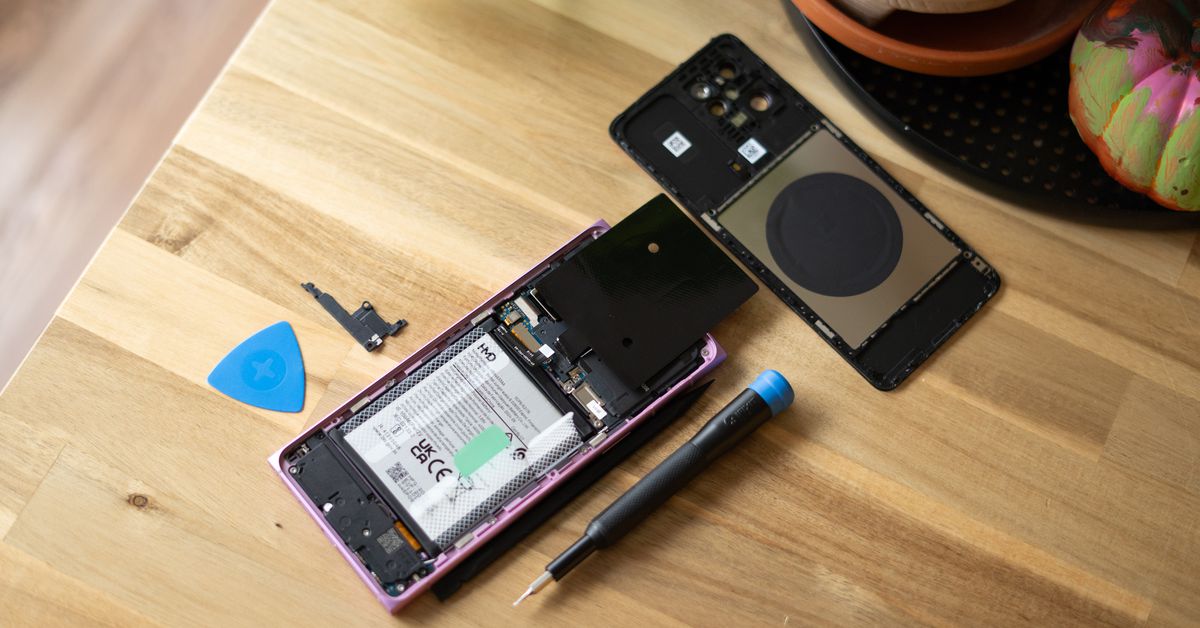My first DIY smartphone repair project was off to an inauspicious start.
I’d successfully removed the back of the HMD Skyline, but the next instruction called for a T3 screwdriver bit. I had a T4 bit, which worked well enough to turn the screw that popped the corner of the phone’s back panel up. But a T4 was just too big for the tiny screws holding the battery connector cover in place. I needed that T3.
The Skyline is one of HMD’s latest user-repairable phones. It’s a midrange phone, one of the first Android phones with Qi2 wireless charging, plus a 6.55-inch OLED panel, three rear cameras, and a big 4,600mAh battery for $449. In my limited use, the Snapdragon 7s Gen 2 seems prone to lagginess, and the 1080p screen resolution really isn’t enough for that big panel.
But most notably, the Skyline represents the continuation of a partnership with iFixit. You can buy spare parts for the Skyline on iFixit’s website, follow along with detailed repair instructions, and pick up the tools you’ll need for the job. My review unit arrived from HMD with a basic iFixit toolkit, which has a good set of starter tools — but not the T3 bit I needed.
Did you know you can walk into your local hardware store and buy something called a “smartphone repair kit?” I didn’t, but I’m glad that you can. I bought the kit as a kind of insurance; I’d been in touch with iFixit to get some replacement parts for the Skyline for testing and wasn’t sure if a T3 was coming in my shipment. It was, as it turned out, along with extra tools, a replacement battery, a replacement back cover, and some rad iFixit stickers. So thoughtful!
I spend a lot of my time using phones, holding phones, being near phones, and considering phones, but I rarely look inside phones. That’s mostly because dismantling a $1,000 device that a company is loaning you is generally considered rude. Phone manufacturers would also prefer you go through their official channels rather than self-repair. But also, I’m kind of a weenie. I’m not very handy and I’m nervous about screwing something up — traits I’m slowly learning to overcome as a homeowner.
I’ll be honest, prying the battery out of the HMD Skyline did make me a little nervous, especially when the disposable tab I was pulling to release it from its adhesive snapped right off. But as with home projects, I’m learning that if you have the right tools on hand, take your time, and consult experts along the way, you can do a lot more than you’d think. iFixit’s guide suggested that the adhesive might be strong enough to require constant, steady pressure. By carefully pulling on the remaining two tabs, I eventually freed the battery from the glue.
I’d successfully followed the steps to remove the phone’s back cover, disconnect the battery, and remove it from the phone. All I needed to do before installing the new battery was to remove a couple of patches of adhesive. I used a spudger and tweezers to peel up most of it, but the sticky remnants needed to go, too. Working one drop at a time, I applied some 90 percent isopropyl alcohol and scrubbed the residue off with a microfiber towel. It was the most tedious and satisfying part of the job.
The most tedious and satisfying part of the job
Incidentally, I’d had to perform the same maneuver in a house project last week, only on a slightly bigger scale. There’s apparently a small crack where the conduit meets our outdoor breaker box that lets a tiny trickle of water into the wall when it rains. It’s something that we’ve had a contractor work on a couple of times, but their fix hasn’t seemed to stick. They’re a big outfit and “tiny crack where a little rain gets into the drywall” is small potatoes for them anyway, so I took it on myself.
That’s how you end up on a ladder outside your house peeling all-weather tape off of a metal box, a few millimeters at a time. But I did as the kind people at the hardware store told me, removing the tape and the residue underneath with some rubbing alcohol and a microfiber towel. The crack is freshly sealed and stood up to a downpour a few days later, and I plan to never shut up about how I fixed the leak in the wall all by myself.
Back to the Skyline. I installed the new battery, swapped in the new back cover, and sealed the whole thing up again. There’s a worrying amount of force and clicking required to get the cover clipped back into place, but I did it. The phone powered up normally and is charging as I write this; iFixit recommends charging it to 100 percent and then keeping it plugged in for an extra two hours to calibrate it.
The ease of this repair wasn’t by accident
The whole process to swap the battery and cover took a couple of hours — including 30 minutes I spent running to the store for some 90 percent isopropyl alcohol. But after taking a look through iFixit’s other phone repair guides, I can appreciate that the ease of this repair wasn’t by accident. If you want to swap out a battery on your Google Pixel 8, you’ll need to complete 42 steps just to get the original battery out; on the HMD Skyline, the whole procedure is just 21 steps.
To be fair, the Pixel 8 is IP68 rated for full dust and water resistance, so it’s just going to be harder to get into. The Skyline is IP54, which is honestly better than I figured considering its repairability status. And unsurprisingly, the Skyline doesn’t feel quite as well made as a less-repairable Pixel or Samsung phone. Maybe you can’t have it all.
If nothing else, the exercise of opening up the Skyline has made me an even bigger proponent of repairable phones. California’s right to repair law, which went into effect over the summer, has surely helped push phone makers to make parts and documentation available to more consumers. But even those technically complying with the law don’t seem to be fully embracing its principles. Maybe those companies should put a little more faith in their customers. After fixing a leak in the wall and replacing a phone battery, my faith in my own self-repair skills is at an all-time high.













